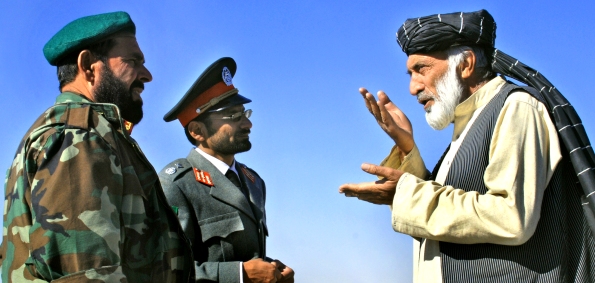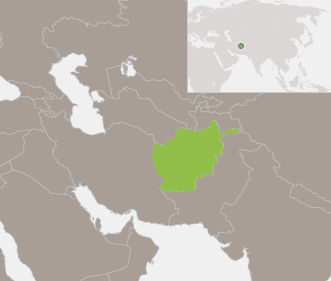
SSR Country Snapshot: Afghanistan
Afghanistan is a post-conflict state in a critical transition phase to taking full control of national security. Security sector reform started in 2001.
--
SSR Snapshot: Table of Contents
1. SSR Summary
2. Key Dates
3. Central SSR Programs/Activities
6. Major Civil Society Stakeholders
7. Key Domestic Government Actors
-
1. SSR Summary
Afghanistan has been in an almost constant state of conflict since the Soviet Union intervention in 1979. The Taliban movement eventually gained control of approximately 90 percent of Afghanistan, ruling large parts of the country from 1996 to 2001.
Anticipating the fall of the Taliban after the September 11 terrorist attacks, the United Nations Security Council (UNSC) passed Resolution 1378 (2001) on November 14 which condemned the Taliban and supported “the efforts of the Afghan people to replace the Taliban regime” and requested that UN member states “provide long term-social assistance for the social and economic reconstruction of Afghanistan” (UNSC, 2001).
The Bonn Agreement in 2001 initiated Afghanistan’s post-conflict state-building process as soon as the Talibans were overthrown by the U.S. Later, the London conference in 2006 sketched a comprehensive post-conflict reconstruction program that included a framework for Afghanistan’s security sector reform (SSR) program.
Initially, different donor countries took responsibilities of Afghanistan’s SSR program, such as the US leading military reform, Germany planning police reform, the United Kingdom leading counter-narcotics, Italy overseeing judicial reform, and Japan leading disarmament, demobilization and reintegration of the ex-combatants. However, the North Atlantic Treaty Organization (NATO) led the International Security Assistance Force (ISAF), which has been operating in Afghanistan since 2001 and later took on training responsibility of the Afghan National Security Forces (ANSF).
Currently, the ANSF is challenged by a critical security condition, insurgency and endemic corruption, heightened by NATO slowly withdrawing its combat troops, with a target of full withdrawal by 2014.
2. Key Dates:
- The SSR program in Afghanistan began in 2001 following the overthrow of the Taliban regime.
- In spring 2002, Afghan SSR processes were launched at a G8 donors’ meeting in Geneva. A multi-sectoral donor support scheme was developed and the SSR agenda was divided into five pillars, each to be overseen by a lead-donor nation.
- NATO Training Mission in Afghanistan (NTM-A) was established in November 2009. The mission aimed to train and monitor Afghan National Security Forces in close cooperation with the Afghan Ministry of Defence and the Ministry of Interior.
- The target year of 2014 was set for Afghanistan to take full responsibility of national security at the 2010 NATO summit in Lisbon and later, confirmed by the Chicago Summit in May 2012.
3. Central SSR Programs/Activities:
Afghan National Army (ANA): Based on the initial plan set by the 2002 conference in Petersburg, Germany, the Afghanistan Compact set the targets of ANA reform. 178,501 troops forms the current ANA as of December 2012 (NATO, 2012b). ANA Special Operations Command currently includes 10,000 commandos and special forces as of May 2012 (NATO, 2012c).
Afghan Air Force (AAF): Currently 6,325 personnel with 96 aircraft constitutes AAF as of December 2012 (NATO, 2012b). The target is to increase the number of AAF personnel to 8000 and aircraft to 140 by 2016.
Afghan National Police (ANP): Afghanistan Compact, which was the product of the 2006 London Conference, set the targets of ANP reform. Currently the total number of officers in ANP is 148,536 as of December 2012 (NATO, 2012b). It appears that the target of 157,000 to be achieved by October 2012 was not met as of December 2012 (NATO, 2012c).
Afghan Local Police (ALP): The number of ALP is 16,300 as of December 2012 and is set to be 30,000 by the end of 2014 (NATO, 2012b; NATO, 2012c). The ALP program is a village-focused program to complement counterinsurgency efforts and is led by the Afghan Ministry of Interior.
Afghan Public Protection Force (APPF): As of December 2012, the APPF consists of 14,000 guards and the target growth is approximately 30,000 guards by March 2013 (NATO, 2012b). According to the Presidential Decree 62, most of Afghan and international Private Security Companies (PSCs) will be dissolved (NATO, 2012c). The security responsibilities of the PSCs will be transferred to the APPF.
4. Key Funding Commitments:
Law and Order Trust Fund for Afghanistan (LOTFA): The fund renewed its commitment to train 5000 female police in Afghan National Police force by 2014. The program, which started in 2010, aims to add a professional body of skilled and qualified female police to the ANP.
NATO-ANA Trust Fund: Apart from funding the transportation and installation of equipment donations for the ANA, this fund is used to train the ANA by the U.S. Combined Security Transition Command-Afghanistan (CSTC-A). The commitment aims for a complete handover of Afghan security responsibility to the ANA by the end of 2014.
5. Major International Donors:
NATO–ANA Trust Fund: supports ISAF’s training of the ANSF (NATO, 2009). The multilateral funding was contributed by Australia, Bulgaria, Czech Republic, Denmark, Estonia, Finland, Germany, Italy, Japan, Lithunia, Luxemberg, Netherlands, Norway, Slovenia, Spain, Sweden, Switzerland, Turkey and the U.K (NATO, 2012d).
The US-Afghan Security Forces Funding: represents the most significant bilateral financial support.
The Law and Order Trust Fund: by the United Nations Development supports the ANP. Among the donors of this fund are Canada, Czech Republic, Denmark, EU, Finland, Germany, Italy, Japan, Netherlands, Norway, Switzerland, U.K. and U.S.A. (UNDP, 2012).
The NATO Equipment Donation Programme: Members of this programs are Bulgaria, Canada, Czech Republic, Estonia, Finland, France, Germany, Hungary, Lithunia, Luxemburg, Montenegro, Norway, Poland, Slovenia, Switzerland, Turkey, U.K. and U.S.A.
The NATO-Russia Council (NRC) Helicopter Maintenance Trust Fund: Established by the NATO-RUssia Council in 2011 (NATO, 2012e)
6. Major Civil Society Stakeholders:
Civil Society and Human Rights Network (CSHRN): An umbrella organization in Afghanistan, engaged in strengthening and promoting rule of law in accordance to the human rights.
The Afghan Women Network (AWN): An umbrella organization for a network of NGOs focusing on empowering women. The AWN established a law department office to advocate, research and promote laws, policies and programs in government that favor and improve woman’s rights.
Afghanistan Independent Human Rights Commission (AIHRC): AIHRC is involved in human rights training, woman’s rights promotion and transitional justice. It also monitors and investigates human rights violation.
7. Key Domestic Government Actors:
Ministry of Defence: Responsible for developing, fielding, and ensuring the operational readiness of the ANA. MoD develops strategic plans for the defense of Afghanistan.
Ministry of Interior: Responsible for establishing security and rule of law. Institutional reform of police, fighting corruption, reducing attrition rate, protection of Afghan borders, rehabilitation of prisoners and supporting intelligence units are among its top ten priorities.
Ministry of Justice: Responsible for drafting, reviewing and proposing legislative document, providing legal and legislative advice to the Ministries and the Government of Afghanistan; acting as legal counsel for the Government; Regulating and managing legal aid services and cooperating with defense counsels, managing affairs related to prisons, detention centers and juvenile rehabilitation centers.
8. Central Challenges:
The clock is ticking for Afghanistan for a critical transition to take full control of its national security as NATO forces set the date for their withdrawal in 2014. Previously, the Afghan National Development Strategy for 2008-2013 identified security and rule of law as two of its three main priority pillars (UNDP, 2008). Despite the declining rate in the Enemy Initiated Attack (EIA), illustrated by the October 2012 ISAF data, the level of violence and civilian casualties still remain significantly high (ISAF, 2012). Therefore, the SSR programs still remain one of the most significant components of Afghanistan’s successful transition process to taking full responsibility of its national security. Currently, the challenges to Afghan security forces are two fold.
First, Afghanistan alone would hardly be able address the increasing cost of the ANSF in the near future. The World Bank report, released in May 2012, projected that Afghanistan’s security spending will reach more than 17.5 percent of its GDP in 2021/22, almost equal to its projected total domestic revenue (World Bank, 2012). Therefore, Afghanistan will not be able to sustain its security expenditure unless the international community maintains and increases the current level of military aid. At the NATO Chicago Summit in 2012, donor countries decided to fund Afghanistan’s security expenses, albeit anticipating that Afghanistan will start financing its own military budget beyond 2024 (NATO, 2012). However, endemic corruption in Afghanistan threatens the accountability and transparency of security expenses (Transparency International, 2011). Also, the austerity plan and sluggish world economy have raised serious doubt on how long international donors will be able to maintain their current level of economic assistance to Afghanistan (Al Jazeera, 2012).
Second, the qualitative outcomes of reform are too early to determine and evaluate its success. The ANSF remains bogged down by insurgency and attrition, despite recent successful transition of three tranches and recent declining trend in the attrition rate (NATO, 2012). How well the ANSF will be able to handle Afghanistan’s security condition in post-2014 remains uncertain. The police reform also is challenged by systemic corruption (Transparency International, 2012). Excessive levels of paramilitarization of the ANP and the lack of adequate training for human rights also undermine the civilian characteristics and division of responsibility among police ranks. Furthermore, the broken judiciary of Afghanistan has been a major challenge to reform (Crisis Group, 2010). Although some improvements are made, reform is slow and difficult as the June 2012 World Bank report demonstrates (World Bank, 2012).
9. For More Information:
NATO Afghanistan: Key developments and updates are available on Afghan SSR on regular basis. The website provides updates on the number of new recruitments and transition tranches.
ISAF Afghanistan: The website provides monthly updates on security condition in Afghanistan which includes data on monthly trend of casualties and enemy initiated attacks.
Dennys, Christiann and Tom Hamilton-Baillie (2012): The CIGI 2012 paper demonstrates that lack of strategic direction and political agreement affects Afghanistan’s SSR program’s success.
If you notice any information that needs to be updated in this SSR Country Snapshot, please let us know! [email protected]






 Visit the Centre for
Visit the Centre for